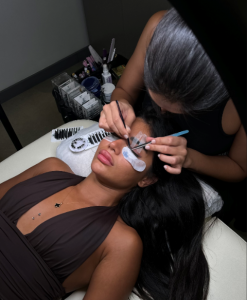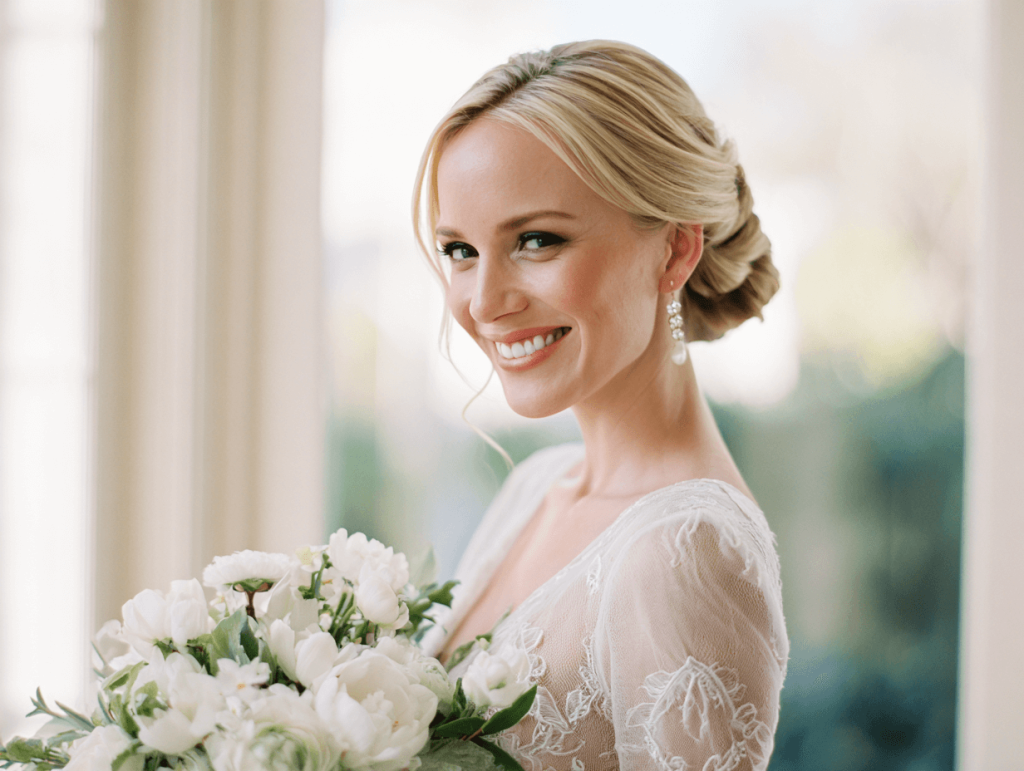
How to Cut Your Own Hair: A Safe, Step-By-Step DIY Haircut
- 7 Minutes

- How to Prepare Before Cutting
- Step-By-Step: Basic At-Home Trim
- Step 1: Decide how much to remove
- Step 2: Section your hair
- Step 3: Choose a cutting technique
- Step 4: Check symmetry and refine
- Step 5: Finish and style
- How to Trim Split Ends At Home
- “Dusting” method for minimal length loss
- Twist & trim for textured or curly hair
- How much to remove and recommended frequency
- Turn At-Home Trims Into Salon-Perfect Styles
- How to Cut Your Own Hair
- Tools & Prep
- Long Hair Trim (Guide Strand Method)
- Bob Haircuts (Blunt vs Textured)
- DIY Layers (Ponytail vs Sectioning)
- Cutting Bangs at Home (Curtain, Blunt, Textured)
- Curly/Wavy Hair
- Common Mistakes & Fixes
- FAQ
Why risk a hair disaster when you can master the art of cutting hair at home? DIY haircuts are growing in popularity as more people seek to trim hair at home while keeping their style intact. With the right tools, techniques, and a steady hand, you can refresh your look safely and confidently between salon visits.
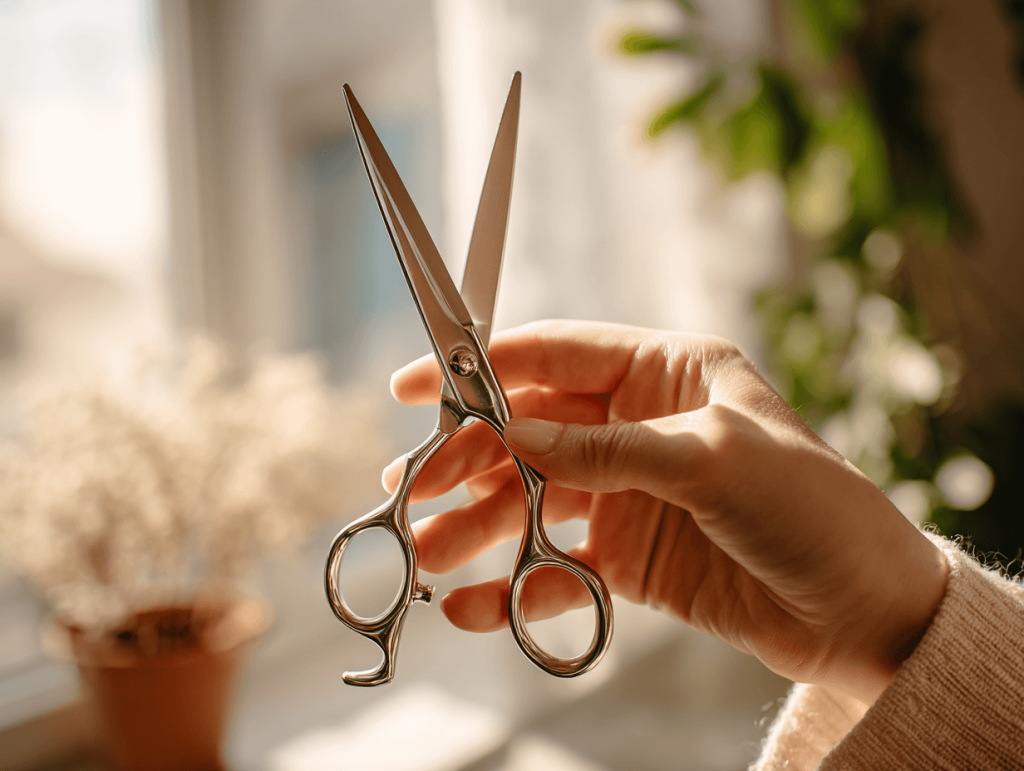
Here are some simple steps for cutting your own hair at home:
- Gather sharp hair-cutting shears, clips, and a mirror setup.
- Detangle your hair and decide whether to cut dry or slightly damp.
- Use guide strands or small sections for even trims.
- Point-cut ends to keep a natural finish.
- Trim a little at a time to avoid over-cutting.
Once you master these basics, even cutting bangs at home or adding soft layers becomes much easier. Follow the right techniques, and your hair will stay polished and stylish until your next professional appointment.
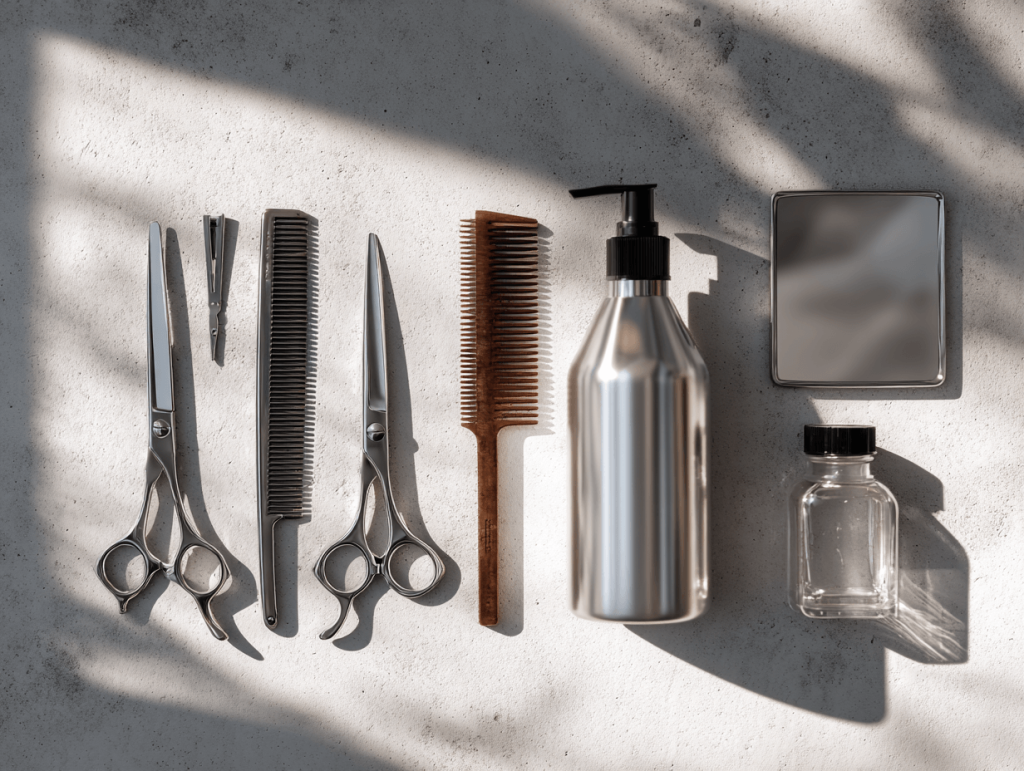
How to Prepare Before Cutting
Proper preparation is essential for a clean, even DIY haircut. It minimizes mistakes and makes trim hair at home smoother and more predictable.
- Wash or dampen hair according to type: wash straight or wavy hair before trimming; cut curly hair dry. Keep a spray bottle handy to re-dampen if needed.
- Detangle completely with a wide-tooth comb.
- Divide hair into 4–6 secure sections and clip them away.
- Use sharp hair-cutting shears, never household scissors.
- Set up mirrors or a phone camera in bright, even lighting to monitor progress.
Still, if you’d rather leave it to the professionals, you can always explore luxury hair services in Istanbul.
Step-By-Step: Basic At-Home Trim
A precise, methodical approach helps you achieve a clean, even haircut without removing too much length. Here is a list of self haircut tips:
| Step | Action | Details / Tips | Common Mistakes to Avoid |
|---|---|---|---|
| 1. Decide how much to remove | Determine trim length | Trim ¼–½ inch to maintain healthy ends. Use a ruler, tape measure, or your fingers as a guide. If unsure, start smaller—you can always cut more later. | Cutting too much at once; not marking length consistently; ignoring damaged ends that may need extra trimming |
| 2. Section your hair | Divide hair into manageable sections | Split hair into 4–6 sections: top, left, right, back (and middle back if needed). Clip sections to keep them separated. Start with a “guide strand” to set the length for all other sections. | Cutting without sections; using uneven guide strand; not securing hair with clips |
| 3. Choose a cutting technique | Select method based on style | Blunt cut: straight across for classic, even ends.Point-cutting: cut vertically at tips for texture and soft edges.Slide cutting: gently slide scissors along strands to remove weight or create movement. | Using wrong technique for hair type (e.g., blunt on curly hair may look bulky); cutting too aggressively |
| 4. Check symmetry and refine | Compare sides | Use a handheld mirror to check the back. Compare left and right sections. Trim tiny amounts at a time to correct unevenness. | Relying only on one mirror; trimming large chunks at once; ignoring hair fall patterns |
| 5. Finish and style | Inspect final shape | Blow-dry or style hair as usual. Check under different lighting. Make light refinements for a polished look. Consider smoothing or adding layers if needed. | Skipping styling before final check; over-trimming after drying; ignoring cowlicks or natural wave patterns |
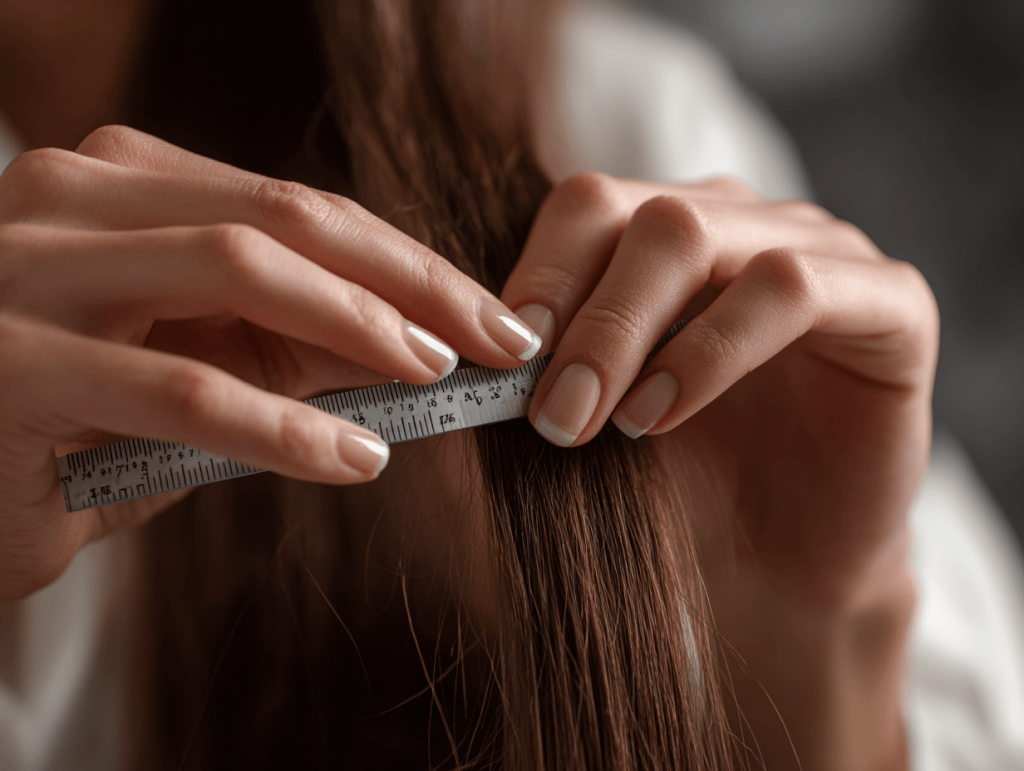
Step 1: Decide how much to remove
Determine the amount to trim, usually ¼ to ½ inch, to maintain healthy ends. Mark the length with a ruler or your fingers to avoid cutting too much, especially if it’s your first time.
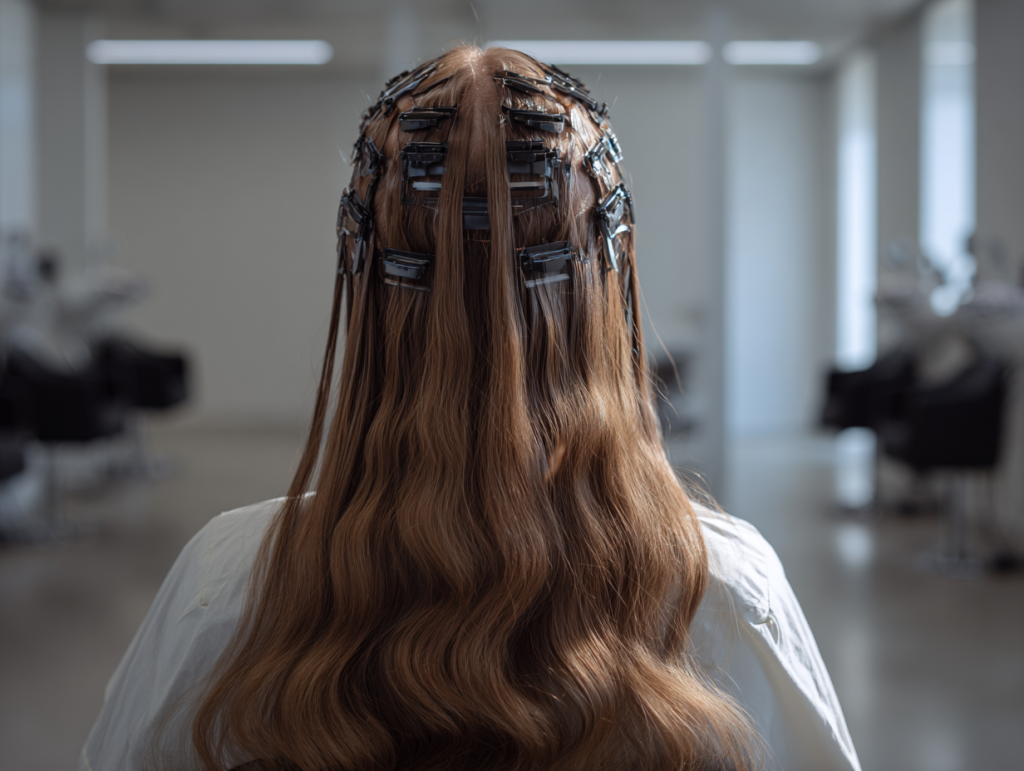
Step 2: Section your hair
Work with 4–6 sections, starting with a guide strand to set the desired length, then match the remaining sections to it.
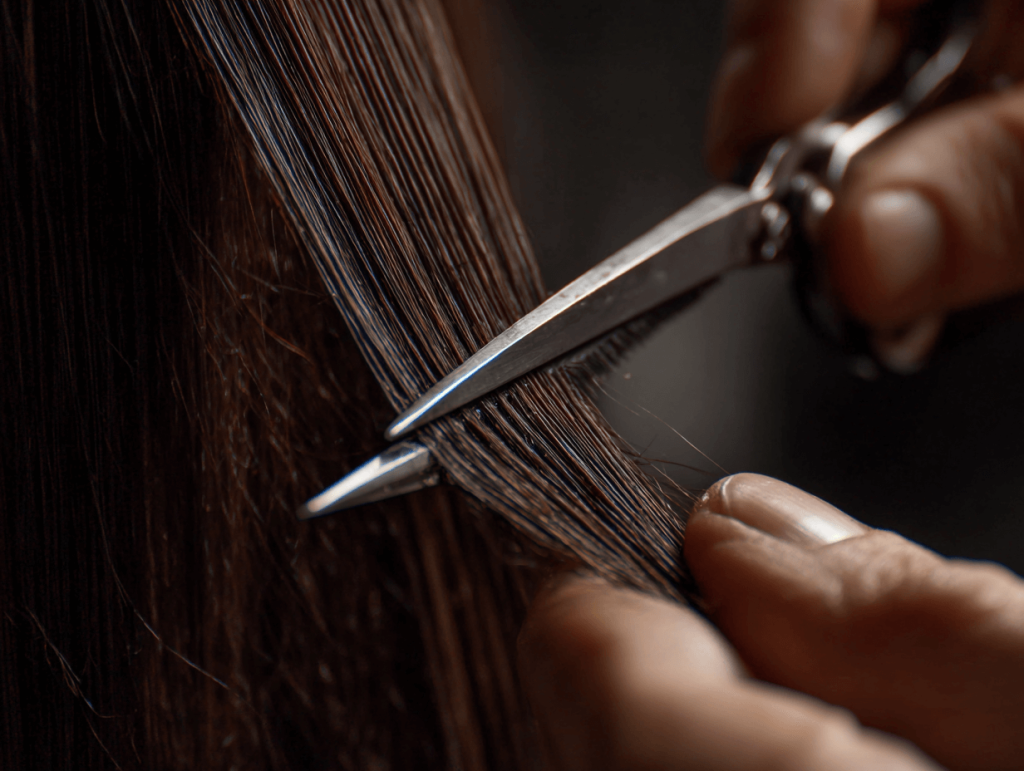
Step 3: Choose a cutting technique
- Blunt cut: straight across for even ends.
- Point-cutting: snip vertically at the tips for texture.
- Slide cutting: slide scissors gently along strands to remove weight or add movement. Select the method that suits your style and hair type.

Step 4: Check symmetry and refine
Compare sides using mirrors and make small adjustments as needed. Trim cautiously rather than cutting large amounts at once.

Step 5: Finish and style
Blow-dry or style your hair to see the final shape. Inspect from different angles and make light refinements if necessary.

How to Trim Split Ends At Home
Regular trims keep hair healthy between salon visits. These simple methods remove split ends while maintaining length and style.
“Dusting” method for minimal length loss
Comb hair straight and snip just the frayed tips (about 1–2 mm) with sharp shears to prevent new splits.
Twist & trim for textured or curly hair
Twist small sections tightly and trim only the hairs sticking out. This preserves curls’ natural shape while removing damaged strands.
How much to remove and recommended frequency
Trim a tiny amount (¼ inch or less) every 6–8 weeks, or more often if hair feels dry or tangles easily, to maintain healthy ends without changing overall length.
Turn At-Home Trims Into Salon-Perfect Styles
DIY haircuts can be fun, but nothing compares to the precision of a professional touch.
At Heli Beauty’s hair salon, we don’t just cut hair, we craft styles that highlight your personality and elevate your look.
Our expert stylists bring years of experience, the latest techniques, and an eye for detail to ensure every strand falls perfectly into place.
Step away from the uncertainty of cutting hair at home and into a world of flawless finishes. Book your appointment today and indulge in the confidence of salon-perfect hairstyles.
How to Cut Your Own Hair
Cutting your own hair at home can feel intimidating, but with the right tools, techniques, and guidance, you can achieve professional-looking results. This guide covers haircuts for women, trims, bobs, layers, bangs, and curly hair, with step-by-step instructions and style-specific tips.
| Step | Tools Needed | Technique | Style-Specific Notes | Common Mistakes | Pro Tips |
|---|---|---|---|---|---|
| Tools & Prep | Hair shears, combs, clips, mirrors, good lighting | Detangle hair; section carefully; check angles | Use secondary mirror or phone camera for back & angles | Dull scissors, poor lighting, skipping sectioning | Decide whether to cut dry or slightly damp; always check symmetry |
| Long Hair Trim (Guide Strand) | Hair shears, combs, clips | Select a guide strand; section hair; trim each section to match guide | Keep trims straight and even | Cutting too much at once; ignoring guide strand | Trim gradually; you can always cut more later |
| Bob Haircuts (Blunt / Textured) | Hair shears, clips, comb | Section evenly; blunt = straight cut, textured = point-cut edges | Check both sides for balance | Uneven cuts; cutting too fast | Work slowly; check symmetry frequently |
| DIY Layers (Ponytail / Sectioning) | Hair shears, combs, clips | Ponytail = gather high, trim gradually; Sectioning = cut each part individually | Layers add volume & dimension | Uneven layers; over-cutting; poor blending | Lightly point-cut edges; blend layers for softness |
| Cutting Bangs (Curtain / Blunt / Textured) | Hair shears, combs, clips | Section triangle at front; cut gradually; dry for curly, damp for straight | Blend bangs with side layers if too short | Over-cutting; uneven bangs | Trim slowly; check face shape compatibility |
| Curly / Wavy Hair | Hair shears, combs | Cut dry; trim small amounts; point-cut for natural movement | Maintain bounce & volume | Cutting too much at once; blunt cuts flatten curls | Work with curl pattern; trim a little at a time |
Tools & Prep
Having the right tools and setup ensures a smooth haircut:
- Professional hair shears, combs, clips, and a reliable mirror setup.
- Good lighting and a secondary mirror or phone camera for different angles.
- Detangle hair and decide whether to cut dry or slightly damp.
- Essential tips: Use sharp scissors, section hair carefully, and check symmetry frequently.
Long Hair Trim (Guide Strand Method)
Keep trims straight and even by following a guide strand.
- Select a guide strand at your desired length.
- Section hair into manageable parts.
- Align each section with the guide and trim slowly.
Style tip: Trim gradually; you can always cut more if needed.
Bob Haircuts (Blunt vs Textured)
Bobs can be sleek or soft. Proper sectioning ensures balance:
- Section hair evenly.
- Blunt bob: cut straight along the guideline for a polished look.
- Textured bob: use point-cutting to soften edges and add movement.
Style tip: Work slowly, checking both sides for evenness.
DIY Layers (Ponytail vs Sectioning)
Layers add volume and dimension:
- Ponytail method: gather hair high and trim gradually for soft, blended layers.
- Sectioning method: cut each section individually for precise layering.
- Blend edges lightly with point-cutting.
Cutting Bangs at Home (Curtain, Blunt, Textured)
Choose the style that suits your face:
- Select curtain, blunt, or textured bangs.
- Cut dry for curly/wavy hair, damp for straight hair.
- Use a triangle section at the front and trim gradually to your desired length.
Style tip: Blend with side layers if bangs end up too short.
Curly/Wavy Hair
Curly and wavy hair requires special attention:
- Cut dry to see the true length.
- Trim small amounts at a time, shaping for bounce and volume.
- Use point-cutting for natural movement.
Common Mistakes & Fixes
- Uneven trims: check mirrors from multiple angles.
- Over-cutting: trim gradually and review frequently.
- Using dull scissors: always use sharp, professional shears.
- Ignoring hair texture: adjust your technique for straight vs curly hair.
FAQ
Yes, cutting your own hair at home is safe if you use the right tools and follow proper techniques. Start with small trims, section your hair carefully, and work slowly to avoid mistakes. Using professional hair shears instead of regular scissors reduces the risk of split ends and uneven cuts.
To cut split ends at home, start by detangling your hair and working in small sections. Use sharp hair shears to trim hair at home, just the damaged tips, ideally using the point-cutting method to blend the ends naturally.
The essential tools for cutting your own hair include:
Professional hair shears for clean, precise cuts
Sectioning clips to keep hair organized
Combs for measuring and guiding cuts
Mirrors (including a secondary mirror or phone camera) to check angles Optional tools include thinning shears, spray bottles, and hair ties, depending on the style you want to achieve.



